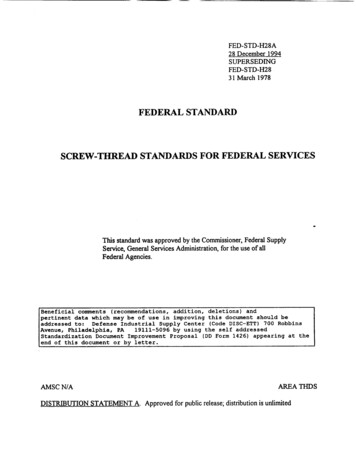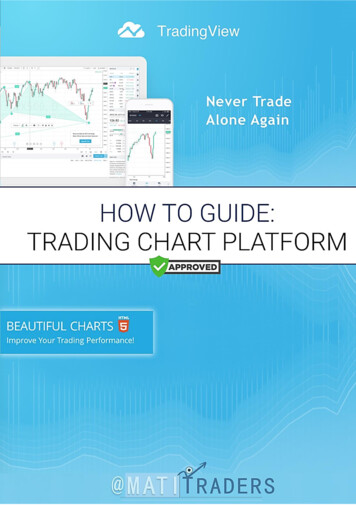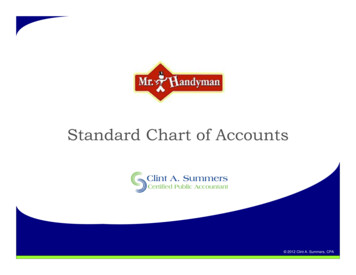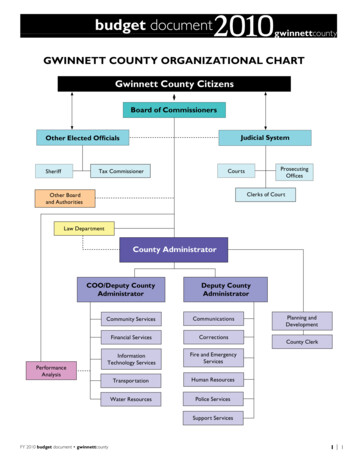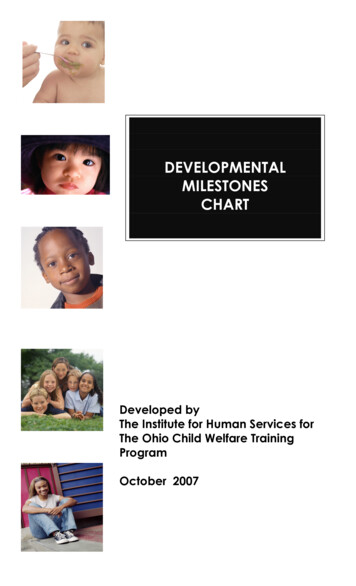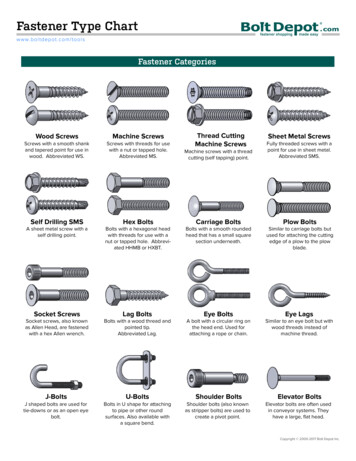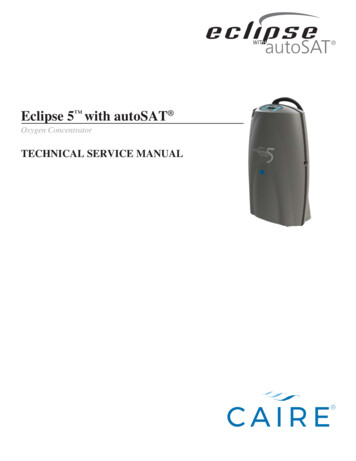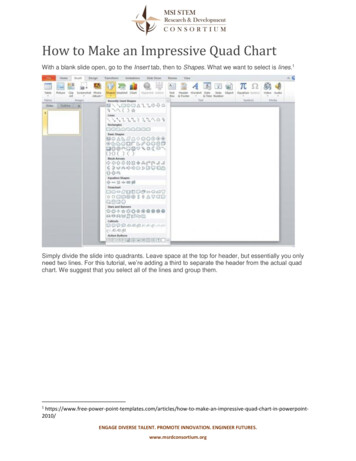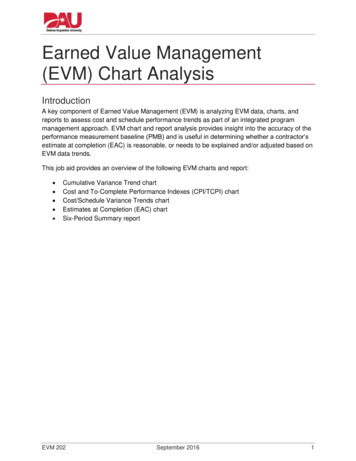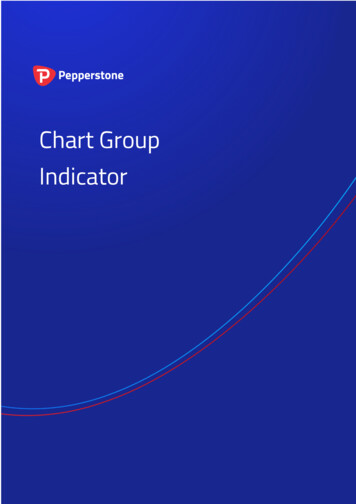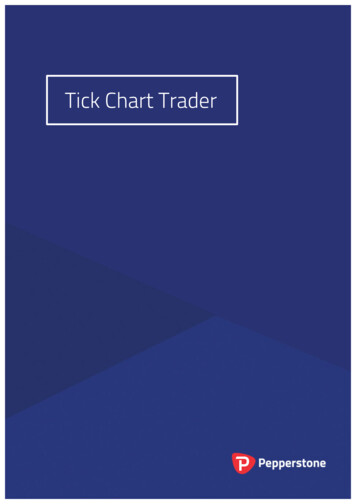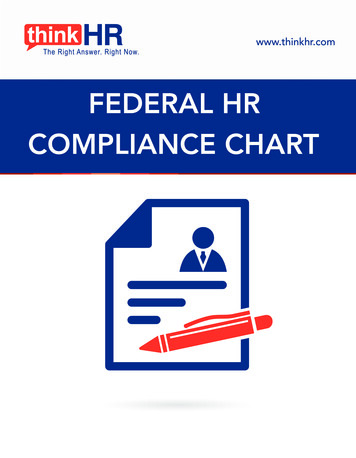
Transcription
www.thinkhr.comFEDERAL HRCOMPLIANCE CHART
HR Compliance AffectsEmployers of All SizesThinkHR grants the reader non-exclusive, non-transferable, and limited permission to use this document. The reader may not sell orotherwise use this document without express permission. ThinkHR provides this document to our clients for general information andencourages users to review the applicable federal and state insurance and labor laws and/or seek guidance from legal counselbefore establishing any company policy or procedures relating to benefits notices.Brokers and their clients who are registered to receive ThinkHR services may contact the HR Hotline at 877-225-1101 withquestions.The following chart provides a basic summary of some of the most common federal laws affecting employers. Many of the coveragerequirements are based upon employer size; however, in some cases, coverage requirements may be based upon other factors (i.e.,size of the contract). More information for each statute is available by clicking on the links. Employers should also check statestatutes to ensure compliance in the jurisdiction(s) where the company operates.Federal StatuteAge Discrimination inEmployment Act(ADEA)(1)(29 U.S.C. § 621)What It DoesProtects people who are 40 or older fromdiscrimination because of age. The law alsomakes it illegal to retaliate against a personbecause the person complained aboutdiscrimination, filed a charge of discrimination,or participated in an employmentdiscrimination investigation or lawsuit.Posting and Notice RequirementsPosting Requirements. Covered by Title VIIposting requirement (see Title VII sectionbelow).Notice Requirements. None.Covers employers with 20 or more employees.Americans withDisabilities Act (ADA)(2)(42 U.S.C. § 12101)Makes it illegal to discriminate against aqualified person with a disability in the privatesector and in state and local governments. Thelaw also makes it illegal to retaliate against aperson because the person complained aboutdiscrimination, filed a charge of discrimination,or participated in an employmentdiscrimination investigation or lawsuit. The lawalso requires that employers reasonablyaccommodate the known physical or mentallimitations of an otherwise qualified individualwith a disability who is an applicant oremployee, unless doing so would impose anundue hardship on the operation of theemployer's business.Posting Requirements. Covered by Title VIIposting requirements (below).Notice Requirements. None.Covers employers with 15 or more employees.(1) http://www.eeoc.gov/laws/statutes/adea.cfm, (2) http://www.eeoc.gov/laws/statutes/ada.cfm1 ThinkHR 2013 - www.thinkhr.com
HR Compliance AffectsEmployers of All SizesFederal StatuteTitle VII of the CivilRights Act of 1964 —Equal EmploymentOpportunities(3)(42 U.S.C. § 2000e et seq.)Civil Rights Act of 1991(6)(42 U.S.C. §§ 1981 – 1996b)What It DoesPosting and Notice RequirementsMakes it illegal to discriminate against someoneon the basis of race, color, religion, nationalorigin, or sex. The law also makes it illegal toretaliate against a person because the personcomplained about discrimination, filed a chargeof discrimination, or participated in anemployment discrimination investigation orlawsuit. The law also requires that employersreasonably accommodate applicants' andemployees' sincerely held religious practices,unless doing so would impose an unduehardship on the operation of the employer'sbusiness.Posting Requirements. Covered employersmust post one of two equal opportunityposters: either the EEOC poster(4), or theDepartment of Labor’s Office of FederalContract Compliance Program’s (OFCCP)Employment Opportunity is the Law Poster.(5)Both posters are accepted as valid by OFCCPand the EEOC. The notice must be postedprominently, where it can be readily seen byemployees and applicants for employment,e.g., personnel office, work-out facility,lunchroom, or company bulletin board. There isno particular size requirement.Covers employers with 15 or more employees.Notice Requirements. NoneAmended Title VII and the ADA to permit jurytrials and compensatory and punitive damageawards in intentional discrimination casesPosting Requirements. Covered by Title VIIposting requirement (above).Notice Requirements. None.Covers employers with 15 or more employees.Title III of the ConsumerCredit Protection Act(CPPA)(7)(15 U.S.C. § 16 71 et seq.)Places restrictions on wage garnishment.Posting Requirements. NoneApplies to all employers and individuals whoreceive earnings for personal services (includingwages, salaries, commissions, bonuses, andperiodic payments from a pension or retirementprogram, but ordinarily does not include tips).Notice Requirements. NoneConsolidated OmnibusBenefits ReconciliationAct (COBRA)(8)(29 U.S.C. § 1161 et seq.)Requires most group health plans to provide atemporary continuation of group healthcoverage that otherwise might be terminated.Posting Requirements. NoneCovers employers with 20 or more employees.Notice Requirements. Group health plansmust provide covered employees and theirfamilies with certain notices(9) explaining theirCOBRA rights. They must also have rules forhow COBRA continuation coverage is offered,how qualified beneficiaries may electcontinuation coverage, and when it can beterminated.(3) http://www.eeoc.gov/laws/statutes/titlevii.cfm, (4) http://www1.eeoc.gov/employers/poster.cfm, (5) fccpost.htm, (6) http://www.eeoc.gov/laws/statutes/cra-1991.cfm,(7) http://www.dol.gov/whd/regs/statutes/garn01.pdf, (8) 18/subchapter-I/subtitle-B/part-6,(9) .html#COBRANoticeandElectionProcedures2 ThinkHR 2013 - www.thinkhr.com
HR Compliance AffectsEmployers of All SizesFederal StatuteThe Contract WorkHours and SafetyStandards Act(CWHSSA)(10)(40 U.S.C. § 3701 et seq.)What It DoesRequires contractors and subcontractors withcovered contracts (over 100,000) to paylaborers and mechanics employed in theperformance of the contract one and one-halftimes their basic rate of pay for all hours workedover 40 in a workweek.Applies to federal service contracts and federaland federally assisted construction contractsover 100,000.Posting and Notice RequirementsPosting Requirements. A poster is required to beposted on all contracts to which CWHSSA applies.The notice to be posted depends on the type offederal procurement contract involved – either theNotice to all Employees Working on Federal orFederally Financed Construction Projects(11) forDavis-Bacon contracts or, for contracts to whichthe Service Contract Act (SCA) applies, theEmployee Rights on Government Contracts(12)must be posted. The appropriate poster(s) mustbe posted at the site of the work in a prominentand accessible place where it may be easily seenby employees. There is no size requirement forthese posters but they must be easily readable.Notice Requirements. NoneCopeland“Anti-Kickback” Act(13)(18 U.S.C. § 874 and 40U.S.C. § 3145)Precludes a contractor or subcontractor frominducing an employee to give up any part of thecompensation to which he or she is entitled underhis or her contract of employment. The Act andimplementing regulations require a contractor andsubcontractor to submit a weekly statement of thewages paid to each employee performing oncovered work during the preceding payroll periodand list payroll deductions that are permissible orrequire consent of the Secretary of Labor.Posting Requirements. NoneNotice Requirements. NoneThe "Anti-Kickback" section of the Copeland Actapplies to all contractors and subcontractorsperforming on any federally funded or assistedcontracts for the construction, prosecution,completion, or repair of any public building orpublic work, except contracts for which the onlyfederal assistance is a loan guarantee and on workperformed on federally funded contracts in excessof 2,000 or federally assisted contracts in excessof 2,000 subject to federal wage standards.This provision applies even where no laborstandards statute covers the contract.(10) http://www.dol.gov/whd/regs/statutes/safe01.pdf, (11) projc.pdf, (12) .htm,(13) 3 ThinkHR 2013 - www.thinkhr.com
HR Compliance AffectsEmployers of All SizesFederal StatuteDavis-Bacon and RelatedActs (DBRA)(14)(40 U.S.C. § 3141a)What It DoesRequires that all contractors and subcontractorsperforming work on federal or District ofColumbia construction contracts in excess of 2,000, or on federally assisted contracts, paytheir laborers and mechanics not less than theprevailing wage rates and fringe benefits.Applies to contractors and subcontractorsperforming on federally funded or assistedcontracts in excess of 2,000 for theconstruction, alteration, or repair (includingpainting and decorating) of public buildings orpublic works.Drug-Free WorkplaceAct of 1988(15)(41 U.S.C. § 8101 et seq.)Posting and Notice RequirementsPosting Requirements. Every employerperforming work covered by the labor standardsof the DBRA must post the WH-1321“Employee Rights Under the Davis-Bacon Act”poster at the site of the work in a prominent andaccessible place where it may be easily seen byemployees. There is no particular sizerequirement. The wage determination must besimilarly posted.Notice Requirements. NoneRequires some federal contractors and allfederal grantees to agree that they will providedrug-free workplaces as a precondition ofreceiving a contract or grant from a federalagency.Posting Requirements. Under the Drug-FreeWorkplace Act, government contractors oremployers receiving federal grants must certifyto the contracting agency that they will maintaina drug-free workplace. This can be done by:Applies to each federal contract or grant on acase-by-case basis. You will need to determinecoverage(16) for each federal contract or grantyou have, or for which you are applying.1. Publishing a statement(17):Notifying employees that the unlawfulmanufacture, distribution, possession, oruse of a controlled substance isprohibited in the workplace,Specifying the action that will be taken forviolations of this policy; and2. Establishing a drug-free awareness programto inform employees about the danger of drugabuse in the workplace, the contractor'sdrug-free policy, available counseling andemployee assistance programs, and penaltiesfor violations.(14) http://www.dol.gov/whd/regs/statutes/dbra.htm, (15) -IV/chapter-81, (16) 7) http://www.dol.gov/elaws/asp/drugfree/require.htm4 ThinkHR 2013 - www.thinkhr.com
HR Compliance AffectsEmployers of All SizesFederal StatuteWhat It DoesPosting and Notice RequirementsNotice Requirements. Government contractorsor employers that have received federal grantsare required to advise employees that they mustreport any criminal drug statute convictionwithin five days of the conviction. The employermust then notify the contracting agency within10 days of learning of the conviction and eitherimpose sanctions against the employee orrequire satisfactory participation in a drug abuseassistance or rehabilitation program.The contracting government agency notesmultiple incidents at any one governmentcontractor or employer and will considertermination or suspension of the contract if thecontractor has failed to make a good-faith effortto provide a drug-free workplace.Employee PolygraphProtection Act (EPPA)(18)(29 U.S.C. § 2001 et seq.)Prohibits most private employers from using liedetector tests, either for pre-employmentscreening or during the course of employment.Applies to most private employers.Posting Requirements. Every employer subjectto EPPA must post and keep posted on itspremises a notice(19) explaining the Act. Thenotice must be posted in a prominent andconspicuous place in every establishment of theemployer where it can readily be observed byemployees and applicants for employment.There is no size requirement for the poster.Notice Requirements. There are specificnotices(20) that must be given to examinees andexaminers in instances where polygraph testsare permitted.(18) 22, (19) a.htm, (20) rs5 ThinkHR 2013 - www.thinkhr.com
HR Compliance AffectsEmployers of All SizesFederal StatuteEmployee RetirementIncome Security Act(ERISA)(21)(29 U.S.C. § 1001 et seq.)What It DoesSets minimum standards for retirement andhealth benefit plans in private industry in theareas of standards of conduct, fiduciary rules,and reporting requirements to the governmentand to the plan participants. ERISA does notrequire any employer to establish a plan butemployers who establish plans must meetcertain minimum standards.ERISA covers retirement, health and otherwelfare benefit plans such as life, disability andapprenticeship plans.Posting and Notice RequirementsPosting Requirements. NoneNotice Requirements – Health Plans. ERISAcontains several notice requirements for healthplans including, but not limited to, a SummaryPlan Description (SPD), special enrollmentnotice, and certificates of creditable coverage.Other notices required by COBRA, HIPAA,WHCRA, the Newborns’ Act, and Michelle’s Lawmay be required depending on the number ofemployees and the benefits offered by the plan.The Reporting and Disclosure Guide forEmployee Benefit Plans(22) can be used as aquick reference tool for certain basic disclosurerequirements under ERISA.Notice Requirements – Retirement Plans.ERISA contains several notice requirements forretirement plans, such as the summary plandescription, individual benefit statements, andthe summary annual report. Employers mayalso use the Reporting and Disclosure Guidefor Employee Benefit Plans(23) as a quickreference tool for this area.The Equal Pay Act(24)(29 U.S.C. § 206)Amended the FLSA to prohibit sex-based wagediscrimination between men and women in thesame establishment who perform jobs thatrequire substantially equal skill, effort andresponsibility under similar working conditions.Posting Requirements. NoneNotice Requirements. NoneApplies to all employers.(21) 18, (22) http://www.dol.gov/ebsa/pdf/rdguide.pdf, (23) http://www.dol.gov/ebsa/pdf/rdguide.pdf, (24) http://www.eeoc.gov/laws/statutes/epa.cfm6 ThinkHR 2013 - www.thinkhr.com
HR Compliance AffectsEmployers of All SizesFederal StatuteExecutive Order11246(25)What It DoesProhibits federal contractors andsubcontractors and federally assistedconstruction contractors and subcontractorsthat generally have contracts exceeding 10,000 from discriminating in employmentdecisions on the basis of race, color, religion,sex, or national origin; and it requires them totake affirmative action to ensure that equalopportunity is provided in all aspects of theiremployment.Covers employers with federal contracts orsubcontracts that exceed 10,000 or that will (orcan reasonably be expected to) accumulate tomore than 10,000 in any 12-month period.Posting and Notice RequirementsPosting Requirements. Contractors andsubcontractors who hold a single federalcontract or subcontract in excess of 10,000 orwho hold contracts or subcontracts with thefederal government in any 12-month period thathave a total value of more than 10,000 arerequired to post the EEO notice, EqualEmployment Opportunity is the Law.(26)Federal contractors and subcontractors who (1)hold government bills of lading; (2) serve as adepository of federal funds in any amount; or (3)act as issuing and paying agents for U.S. savingsbonds and notes must also post the EEO notice.The notice must be posted in conspicuousplaces available to employees and applicantsfor employment and representatives of eachlabor union with which the covered contractoror subcontractor has a collective bargainingagreement, such as, the personnel office,work-out facility, lunchroom, or companybulletin board. There is no particular sizerequirement.Notice Requirements. None(25) , (26) fccpost.htm7 ThinkHR 2013 - www.thinkhr.com
HR Compliance AffectsEmployers of All SizesFederal StatuteFair Credit Reporting Act(FCRA)(27)(15 U.S.C. § 1681 et seq.)What It DoesGoverns the use of consumer reports byemployers (background checks).Posting and Notice RequirementsPosting Requirements. NoneNotice Requirements. Employers must:Applies to all employers.1. Provide applicants with a clear writtendisclosure that a consumer report may beobtained for employment purposes;2. Certify to consumer reporting agencies thatthey have fully complied with FCRA's disclosurerequirements;3. Provide notice to applicants/employees ofcontemplated adverse action based on aconsumer report, together with a description inwriting of the applicant's/ employee's rightsunder FCRA (Summary of Rights Under theFair Credit Reporting Act)(28); and4. Provide notice to applicants/ employees ofan adverse action determination (such asrejection of an applicant or discharge of anemployee) based on a consumer report, withvarious additional information.(27) 41/subchapter-III, (28) http://www.ftc.gov/os/2004/07/040709fcraappxf.pdf8 ThinkHR 2013 - www.thinkhr.com
HR Compliance AffectsEmployers of All SizesFederal StatuteFair Labor Standards Act(FLSA) of 1938(29)(29 U.S.C. § 201 et seq.)What It DoesEstablishes standards for minimum wages,overtime, recordkeeping and child labor.The Act applies to enterprises with employeeswho engage in interstate commerce, producegoods for interstate commerce, or handle, sell,or work on goods or materials that have beenmoved in or produced for interstate commerce.For most firms, a test of not less than 500,000 inannual dollar volume of business applies (i.e.,the Act does not cover enterprises with less thanthis amount of business).However, the Act does cover the followingregardless of their dollar volume of business:hospitals; institutions primarily engaged in thecare of the sick, aged, mentally ill, or disabledwho reside on the premises; schools for childrenwho are mentally or physically disabled or gifted;preschools, elementary and secondary schools,and institutions of higher education; and federal,state, and local government agencies.Employees of firms that do not meet the 500,000 annual dollar volume test may becovered in any workweek when they areindividually engaged in interstate commerce,the production of goods for interstatecommerce, or an activity that is closely relatedand directly essential to the production of suchgoods.In addition, the Act covers domestic serviceworkers, such as day workers, housekeepers,chauffeurs, cooks, or full time babysitters, if theyreceive at least 1,700 in 2009 in cash wagesfrom one employer in a calendar year, or if theywork a total of more than eight hours a week forone or more employers. (This calendar yearthreshold is adjusted by the Social SecurityAdministration each year.) For additionalcoverage information, see the Wage and HourDivision Fact Sheet #14: Coverage Under theFLSA.(30)Posting and Notice RequirementsPosting Requirements. Every employer ofemployees subject to the FLSA’s minimum wageprovisions must post, and keep posted, a noticeexplaining the Act in a conspicuous place in allof their establishments. Although there is nosize requirement for the poster, employees mustbe able to readily read it.Covered employers are required to post thegeneral Fair Labor Standards Act poster;however, certain industries have postersdesigned specifically for them. Employers ofAgricultural Employees(31) and State & LocalGovernment Employees(32 )can eith
HR Compliance Affects Employers of All Sizes 1 ThinkHR grants the reader non-exclusive, non-transferable, and limited permission to use this document. The reader may not sell or otherwise use this document without express permission. ThinkHR provides File Size: 1MBPage Count: 26People also search forhr compliance managementhr compliance key dateshr compliance calendar 2021hr contractor positionsHR Compliance statementmaryland HR law drug use
